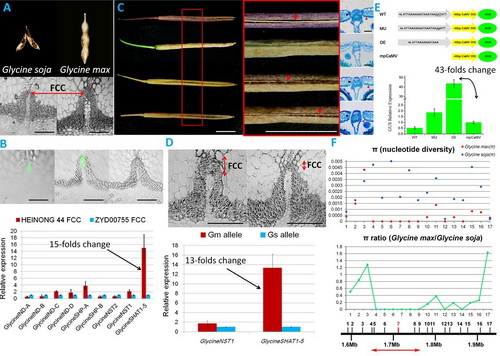中科院植物所王印政在Nature子刊发表栽培大豆果实裂荚抗性文章
中国科学院植物研究所王印政研究组针对栽培大豆果实裂荚抗性这一关键驯化性状展开了全面而深入的研究。相关文章发表于2014年2月19日的《Nature Communications》杂志上。论文的第一作者是董阳博士。

栽培大豆果荚裂荚抗性产生的细胞学和遗传调控机制。(A)栽培大豆与野生大豆果荚裂荚性状的对比解剖学分析;(B)SHAT1-5基因表达模式分析以及栽培大豆与野生大豆FCC基因表达对比分析;(C)SHAT1-5基因编码区在拟南芥nst1-1;nst3-1突变体中的功能验证;(D)SHAT1-5基因在栽培大豆与野生大豆杂交F2分离群体中功能和表达分析;(E)GARP顺式作用元件功能分析;(F)SHAT1-5基因位点以及周边区域的选择分析。
果实落粒抗性作为古代人类首先选择的重要农艺性状被认为是作物驯化的里程碑。栽培大豆是人类最重要的植物油和蛋白来源,其果实的裂荚抗性是重要的驯化性状。20世纪90年代以来,人们一直在利用多种手段试图找到这一性状的控制基因,但均未取得突破。
研究人员首先发现果荚腹缝线维管束细胞壁剧烈增厚的纤维帽细胞(Fiber Cap Cells, FCC)是决定栽培大豆果实裂荚抗性的关键细胞结构,而离层细胞在野大豆和栽培大豆之间并没有发生变化。
他们进一步开展了免疫组织化学蛋白定位、激光捕获显微切割微量组织基因表达分析、基因功能互补实验、遗传学分析、大区段基因组(365kb)人工选择痕迹的检测以及相关功能元件的发现和验证等一系列研究。
结果显示,从野大豆到栽培大豆的驯化过程中强烈的人工选择使NAC基因家族SHAT1-5基因上游4kb处的一个抑制子被彻底清除,使SHAT1-5在栽培大豆纤维帽细胞中的表达剧烈上调,表达强度较野大豆提高了15倍,导致其次生壁显著加厚,从而有效阻止了果荚的自然开裂过程。
HAT1-5基因座位的强烈人工选择导致栽培大豆基因组第16号染色体产生~116kb区段的DNA多态性选择性清除。该机制与禾谷类作物由离层的失去导致落粒抗性的分子机制完全不同。该基因及其相关调控机制在豆类新品种培育和分子育种中具有重要应用前景。
该研究工作得到国家科技基础性工作专项和国家自然科学基金重大项目的资助。
原文摘要:
Pod shattering resistance associated with domestication is mediated by a NAC gene in soybean
Yang Dong, Xia Yang, Jing Liu, Bo-Han Wang, Bo-Ling Liu & Yin-Zheng Wang
Loss of seed dispersal is a key agronomical trait targeted by ancient human selection and has been regarded as a milestone of crop domestication. In this study, in the legume crop soybean Glycine max (L.) Merr. which provides vegetable oils and proteins for humans, we show that the key cellular feature of the shattering-resistant trait lies in the excessively lignified fibre cap cells (FCC) with the abscission layer unchanged in the pod ventral suture. We demonstrate that a NAC (NAM, ATAF1/2 and CUC2) gene SHATTERING1-5 (SHAT1-5) functionally activates secondary wall biosynthesis and promotes the significant thickening of FCC secondary walls by expression at 15-fold the level of the wild allele, which is attributed to functional disruption of the upstream repressor. We show that strong artificial selection of SHAT1-5 has caused a severe selective sweep across ~116 kb on chromosome 16. This locus and regulation mechanism could be applicable to legume crop improvement.

